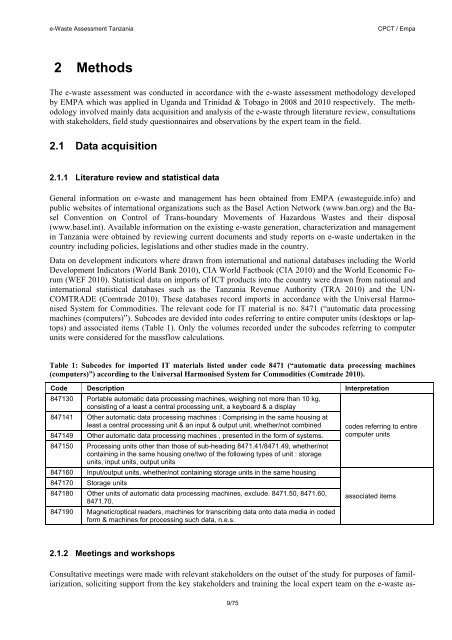e-Waste Assessment Tanzania - e-Waste. This guide
e-Waste Assessment Tanzania - e-Waste. This guide
e-Waste Assessment Tanzania - e-Waste. This guide
- No tags were found...
Create successful ePaper yourself
Turn your PDF publications into a flip-book with our unique Google optimized e-Paper software.
e-<strong>Waste</strong> <strong>Assessment</strong> <strong>Tanzania</strong>CPCT / Empa2 MethodsThe e-waste assessment was conducted in accordance with the e-waste assessment methodology developedby EMPA which was applied in Uganda and Trinidad & Tobago in 2008 and 2010 respectively. The methodologyinvolved mainly data acquisition and analysis of the e-waste through literature review, consultationswith stakeholders, field study questionnaires and observations by the expert team in the field.2.1 Data acquisition2.1.1 Literature review and statistical dataGeneral information on e-waste and management has been obtained from EMPA (ewaste<strong>guide</strong>.info) andpublic websites of international organizations such as the Basel Action Network (www.ban.org) and the BaselConvention on Control of Trans-boundary Movements of Hazardous <strong>Waste</strong>s and their disposal(www.basel.int). Available information on the existing e-waste generation, characterization and managementin <strong>Tanzania</strong> were obtained by reviewing current documents and study reports on e-waste undertaken in thecountry including policies, legislations and other studies made in the country.Data on development indicators where drawn from international and national databases including the WorldDevelopment Indicators (World Bank 2010), CIA World Factbook (CIA 2010) and the World Economic Forum(WEF 2010). Statistical data on imports of ICT products into the country were drawn from national andinternational statistical databases such as the <strong>Tanzania</strong> Revenue Authority (TRA 2010) and the UN-COMTRADE (Comtrade 2010). These databases record imports in accordance with the Universal HarmonisedSystem for Commodities. The relevant code for IT material is no. 8471 (“automatic data processingmachines (computers)”). Subcodes are devided into codes referring to entire computer units (desktops or laptops)and associated items (Table 1). Only the volumes recorded under the subcodes referring to computerunits were considered for the massflow calculations.Table 1: Subcodes for imported IT materials listed under code 8471 (“automatic data processing machines(computers)”) according to the Universal Harmonised System for Commodities (Comtrade 2010).Code Description Interpretation847130 Portable automatic data processing machines, weighing not more than 10 kg,consisting of a least a central processing unit, a keyboard & a display847141 Other automatic data processing machines : Comprising in the same housing atleast a central processing unit & an input & output unit, whether/not combined847149 Other automatic data processing machines , presented in the form of systems.847150 Processing units other than those of sub-heading 8471.41/8471.49, whether/notcontaining in the same housing one/two of the following types of unit : storageunits, input units, output units847160 Input/output units, whether/not containing storage units in the same housing847170 Storage units847180 Other units of automatic data processing machines, exclude. 8471.50, 8471.60,8471.70.847190 Magnetic/optical readers, machines for transcribing data onto data media in codedform & machines for processing such data, n.e.s.codes referring to entirecomputer unitsassociated items2.1.2 Meetings and workshopsConsultative meetings were made with relevant stakeholders on the outset of the study for purposes of familiarization,soliciting support from the key stakeholders and training the local expert team on the e-waste as-9/75
















